When it comes to choosing a trampoline, there are several factors to consider. First and foremost, you’ll want to think about the size and shape of the trampoline. This will largely depend on the available space you have in your backyard or wherever you plan to use the trampoline.
Next, consider the weight limit of the trampoline and choose one that can accommodate the weight of all potential users. Safety features are also important, such as enclosure nets, padding, and sturdy frames.
You’ll want to ensure that the trampoline you choose has the necessary safety features to protect you and your loved ones from injuries.
Materials and construction quality are also important to consider. Look for trampolines made with durable materials, such as steel frames and high-quality mats and springs. Additionally, it’s important to consider your budget and balance the quality of the trampoline with its cost.
Finally, proper maintenance and care are crucial to ensure the longevity and safety of your trampoline. By keeping all of these factors in mind, you can make an informed decision and choose the perfect trampoline for your needs.
How to choose a trampoline: Choosing a trampoline requires careful consideration of several factors, including size, shape, weight limit, safety features, materials, construction quality, budget, and maintenance. By taking the time to consider these factors, you can find a trampoline that meets your needs and provides years of fun and safe bouncing.
How to choose a trampoline?
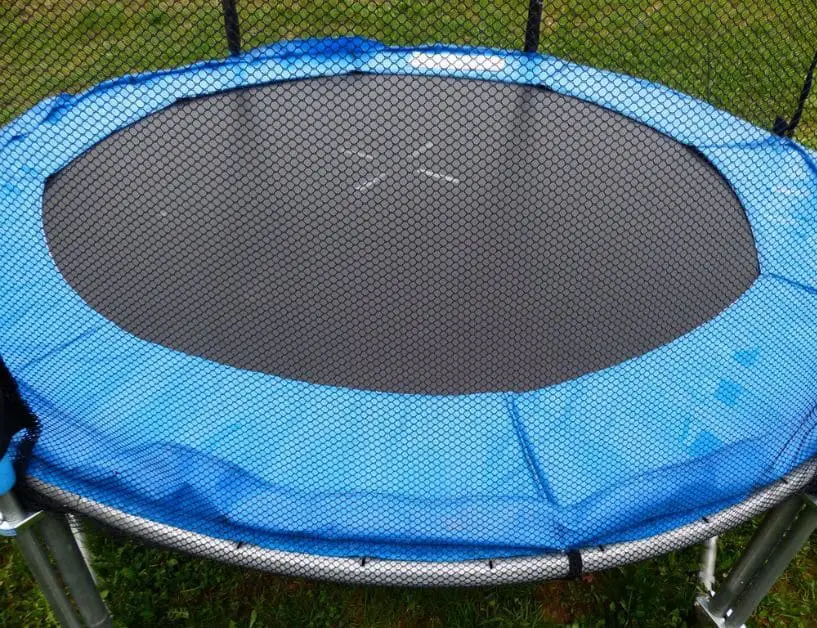
When I decided to purchase a trampoline for my backyard, I realized that there were many options to choose from. After doing some research, I found that the first thing to consider is the size of the trampoline.
I had to make sure that it would fit in my yard and that there would be enough space for safety around it.
The weight limit was also important to me, as I wanted a trampoline that could accommodate both children and adults. Safety features such as enclosure nets, padding, and sturdy frames were non-negotiables for me.
Lastly, I looked for a reputable brand with good reviews to ensure that I was investing in a quality product that would last for years to come.
Types of Trampolines
Trampolines come in various shapes, sizes, and types. Here are some of the most common types of trampolines:
1. Round Trampolines
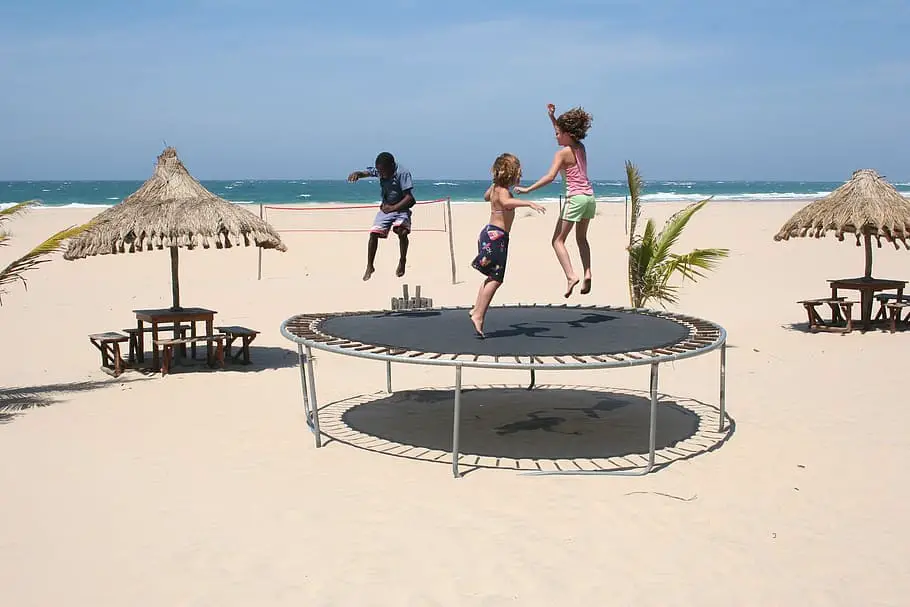
Round trampolines are the most popular type of trampoline and are typically the least expensive. They come in various sizes, ranging from small 8-foot models to large 16-foot models. Round trampolines are best for recreational use and are great for families with young children.
Advantages:
- Round trampolines are less expensive than other types of trampolines
- They’re easy to set up and maintain
- They provide a consistent bounce throughout the jumping area
Disadvantages:
- Round trampolines are not ideal for advanced tricks or gymnastics
- They have a smaller jumping surface than other types of trampolines
- They have a lower weight limit compared to other types of trampolines
2. Rectangular Trampolines
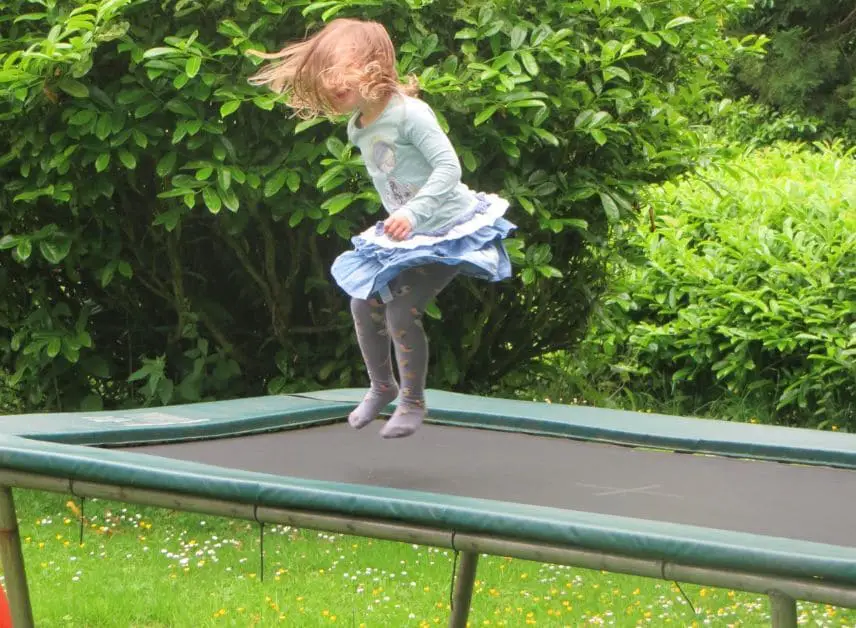
Rectangular trampolines are best for gymnasts, athletes, and advanced jumpers who need a larger surface area for jumping. They provide a higher bounce compared to round trampolines and are better suited for high-performance tricks and flips.
Advantages:
- Rectangular trampolines have a larger jumping surface compared to round trampolines
- They provide a higher bounce, making them ideal for advanced tricks and gymnastics
- They have a higher weight limit compared to round trampolines
Disadvantages:
- Rectangular trampolines are more expensive than round trampolines
- They require more space to set up and maintain
- They can be more challenging to assemble and disassemble
3. Oval Trampolines
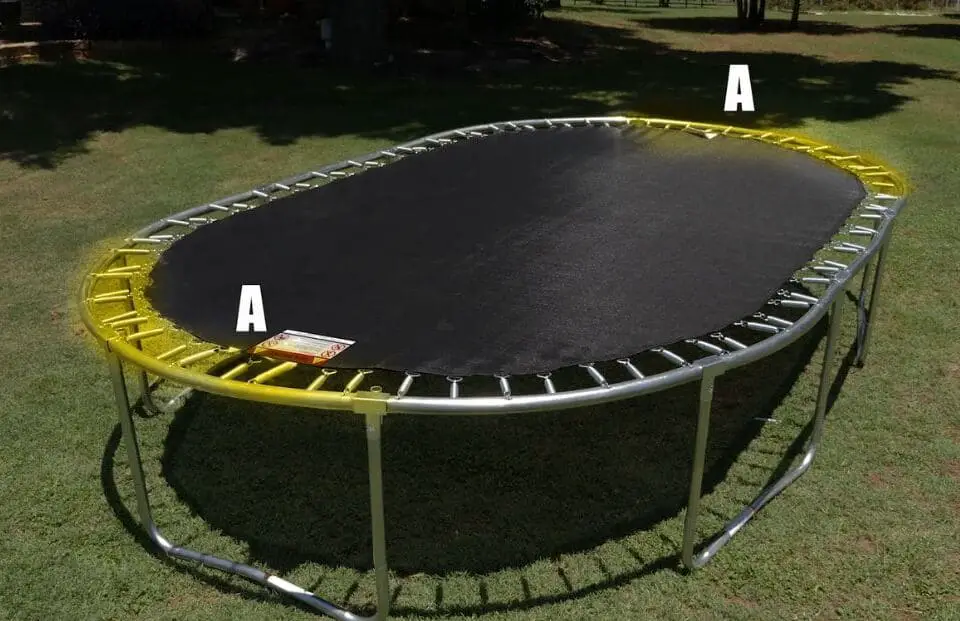
Oval trampolines are a great option for families with larger backyards who want a trampoline that can accommodate multiple jumpers. They offer a combination of round and rectangular trampoline designs, providing a larger surface area and a higher bounce.
Advantages:
- Oval trampolines have a larger jumping surface compared to round trampolines
- They provide a higher bounce, making them ideal for advanced tricks and gymnastics
- They offer more space for multiple jumpers compared to round trampolines
Disadvantages:
- Oval trampolines are more expensive than round trampolines
- They require more space to set up and maintain
- They can be more challenging to assemble and disassemble
4. Square Trampolines
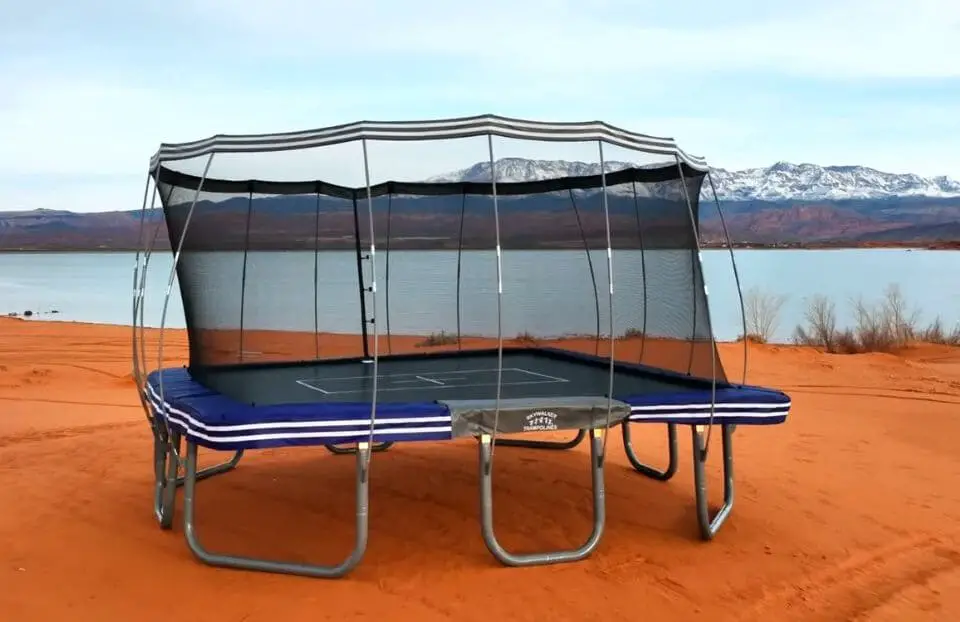
Square trampolines are similar to rectangular trampolines, but they have a more even bounce across the jumping surface. They’re a great option for families who want a larger surface area for jumping but don’t have as much space as required for a rectangular trampoline.
Advantages:
- Square trampolines have a larger jumping surface compared to round trampolines
- They provide a higher bounce, making them ideal for advanced tricks and gymnastics
- They’re a good alternative to rectangular trampolines for families with limited space
Disadvantages:
- Square trampolines are more expensive than round trampolines
- They require more space to set up and maintain than round trampolines
- They can be more challenging to assemble and disassemble than round trampolines
5. Springfree Trampolines
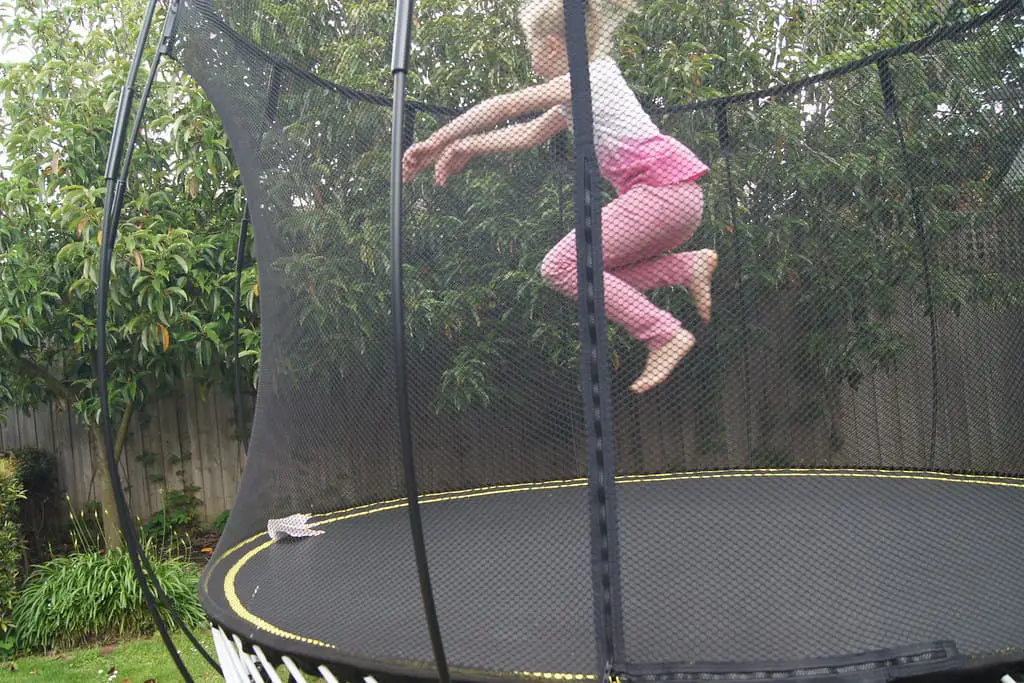
Springfree trampolines are a unique type of trampoline that uses flexible composite rods instead
of traditional metal springs to provide a safer jumping experience. They’re ideal for families with young children or anyone concerned about the safety of traditional trampolines.
Advantages:
- Springfree trampolines are safer than traditional trampolines because they don’t have metal springs
- They provide a consistent bounce throughout the jumping surface
- They’re easy to set up and maintain
Disadvantages:
- Springfree trampolines are more expensive than traditional trampolines
- They have a smaller jumping surface compared to some other types of trampolines
- They may not be ideal for advanced tricks or gymnastics
6. In-ground Trampolines
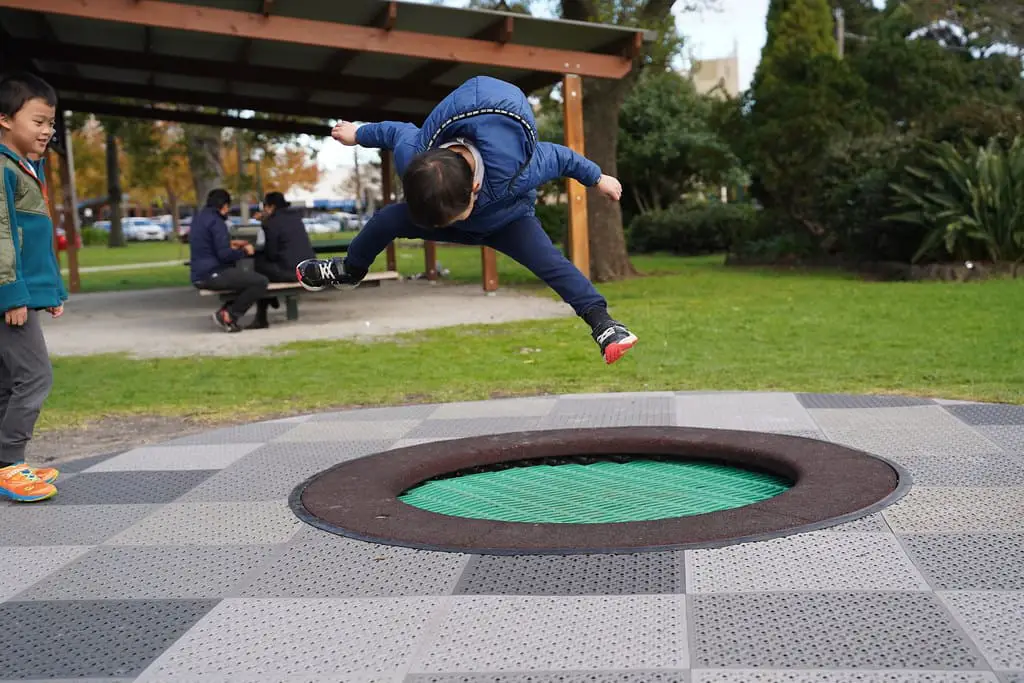
In-ground trampolines are installed at ground level, providing a sleek and seamless look in your backyard. They’re ideal for anyone who wants a trampoline that blends in with their landscaping and doesn’t take up as much space as an above-ground model.
Advantages:
- In-ground trampolines blend in with your landscaping, providing a seamless look in your backyard
- They’re safer than above-ground trampolines because they don’t have a high elevation
- They can be used for advanced tricks and gymnastics
Disadvantages:
- In-ground trampolines are more expensive than above-ground trampolines
- They require more time and effort to install compared to above-ground trampolines
- They may require more maintenance than above-ground trampolines due to potential water drainage issues
7. Mini Trampolines
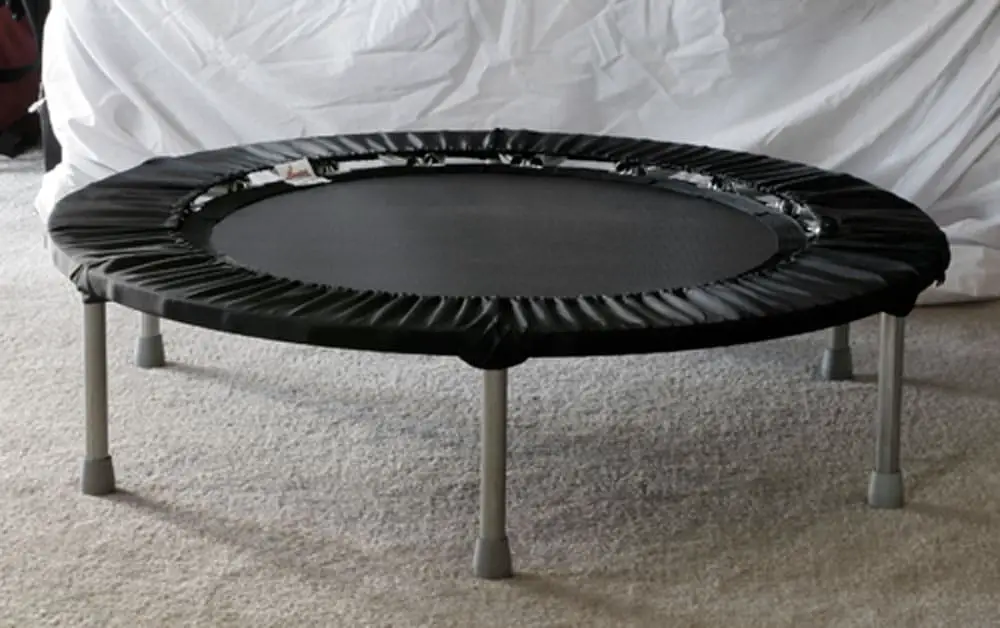
Mini trampolines, also known as rebounders, are small trampolines designed for indoor use. They’re a great option for anyone who wants to improve their balance, coordination, and cardiovascular health from the comfort of their own home.
Advantages:
- Mini trampolines are small and easy to store
- They can be used for indoor exercise regardless of the weather
- They’re less expensive than larger outdoor trampolines
Disadvantages:
- Mini trampolines have a smaller jumping surface compared to outdoor trampolines
- They provide a lower bounce compared to outdoor trampolines
- They may not be ideal for advanced tricks or gymnastics
Safety Considerations
Trampolines can provide hours of fun and entertainment, but it’s important to remember that they can also be dangerous if not used safely.
In this section, we’ll discuss the importance of safety when using a trampoline, the different safety features to look for, and tips on how to use a trampoline safely.
Importance of Safety
According to the American Academy of Pediatrics, trampolines are responsible for thousands of injuries each year, many of which are serious enough to require hospitalization. Common injuries include fractures, dislocations, and head injuries.
It’s important to remember that trampolines are not toys, and they should be used with caution. By following safety guidelines and using the right safety equipment, you can help reduce the risk of injury.
Safety Features
When purchasing a trampoline, it’s important to look for certain safety features, including:
Enclosure nets: A net enclosure around the trampoline can help prevent falls off the trampoline and keep users from hitting the ground or other objects.
Padding: Padding around the frame and springs can help protect users from injury if they land on the frame or springs.
Sturdy frame: A sturdy frame can help prevent the trampoline from tipping over during use.
Weight limit: Trampolines should have a weight limit listed by the manufacturer. Make sure to adhere to this limit to avoid accidents.
Tips for Safe Trampoline Use
Here are some tips on how to use a trampoline safely:
- Always supervise children when they’re using the trampoline.
- Only one person should use the trampoline at a time.
- Do not attempt advanced tricks or gymnastics without proper training and supervision.
- Use the trampoline on a level surface away from trees, buildings, and other objects.
- Do not allow children under six years old to use a full-sized trampoline.
- Always use the safety features provided, including an enclosure net and padding.
- Do not use the trampoline if it’s wet or has ice on it.
- Do not jump off the trampoline; instead, climb down the ladder.
- Do not use the trampoline without adult supervision if you’re under 18 years old.
- Do not place any objects, including toys, on the trampoline.
Size and Weight Limits
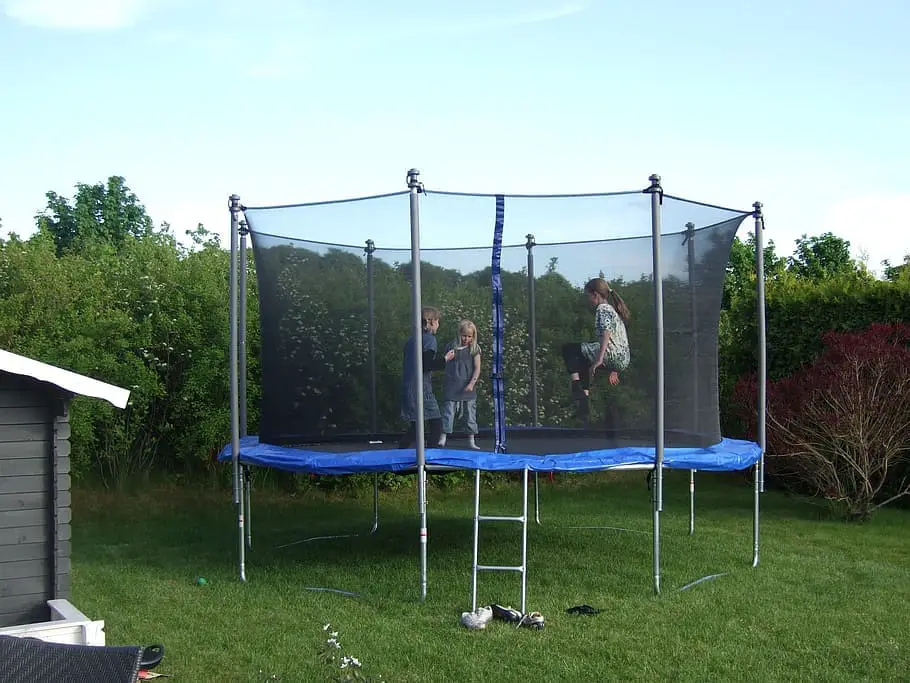
When it comes to purchasing a trampoline, it’s important to consider the size and weight limits to ensure safety and proper usage.
In this section, we’ll discuss how to determine the appropriate size of a trampoline based on available space, the weight limits for different trampolines, and how to choose a trampoline that can accommodate the user’s weight and the weight of other potential users.
Determining the Appropriate Size
Before purchasing a trampoline, it’s important to consider the available space where it will be used. Trampolines come in a range of sizes, from small 8-foot round trampolines to large 15-foot rectangular trampolines.
Here are some general guidelines for choosing the appropriate size trampoline based on available space:
Small yards: For small yards or limited space, an 8-10 foot round trampoline may be appropriate.
Medium yards: For medium-sized yards, a 12-14-foot round trampoline or 14-foot rectangular trampoline may be appropriate.
Large yards: For larger yards or ample space, a 15-foot rectangular trampoline may be appropriate.
It’s important to measure the available space and choose a trampoline that will fit comfortably without overcrowding the area. Keep in mind that there should be at least 3-4 feet of clear space around the trampoline to allow for safe use.
Weight Limits
Each trampoline has a weight limit listed by the manufacturer, and it’s important to adhere to this limit to ensure safety and proper usage. Exceeding the weight limit can result in damage to the trampoline or injury to the user.
Here are some general weight limits for different types of trampolines:
- 8-10 foot round trampolines: Typically have a weight limit of 200-250 pounds.
- 12-14 foot round trampolines: Typically have a weight limit of 250-350 pounds.
- 14-15 foot rectangular trampolines: Typically have a weight limit of 350-450 pounds.
It’s important to choose a trampoline with a weight limit that can accommodate the user’s weight and the weight of other potential users.
Keep in mind that multiple people using the trampoline at the same time will increase the total weight on the trampoline, so choose a trampoline with a weight limit that allows for this.
Choosing a Trampoline Based on Weight
When choosing a trampoline, it’s important to consider the weight of the user and other potential users. Here are some general guidelines:
Children: For children under 100 pounds, a small 8-10 foot round trampoline may be appropriate.
Teens and adults: For teens and adults over 100 pounds, a 12-14-foot round trampoline or 14-foot rectangular trampoline may be appropriate.
Heavy users: For heavy users over 200 pounds, a 14-15 foot rectangular trampoline may be appropriate.
It’s important to choose a trampoline with a weight limit that can accommodate the weight of the user and other potential users. This will help ensure safety and proper usage.
Materials and Construction
Trampolines are a popular recreational item for families, athletes, and fitness enthusiasts. They are constructed using a variety of materials, each with its advantages and disadvantages.
In this section, we’ll discuss the different materials used in trampoline construction, the quality standards to look for in each material, and how to choose the right materials and construction quality for your intended use.
Steel Frame
The frame is the backbone of the trampoline and is responsible for supporting the weight of the user and the tension of the springs. Most trampoline frames are made from steel, with varying levels of thickness and strength.
When considering a trampoline frame, it’s important to look for the following quality standards:
The gauge of steel: A lower gauge number indicates a thicker and stronger steel frame.
Galvanization: Look for frames that have been galvanized to prevent rust and corrosion.
Welding: High-quality welding will ensure a stronger and more durable frame.
For heavy use, a thicker and stronger steel frame may be necessary, while for occasional or light use, a thinner steel frame may be sufficient.
Springs
Springs are an important component of the trampoline and are responsible for creating tension and providing bounce. Most trampolines use metal springs, although some use elastic bands or bungee cords.
When considering trampoline springs, look for the following quality standards:
Length: Longer springs provide greater bounce and are generally considered higher quality.
Gauge: A lower gauge number indicates a thicker and stronger spring.
Galvanization: Look for springs that have been galvanized to prevent rust and corrosion.
Higher-quality springs will provide better bounce and last longer. It’s important to consider the intended use of the trampoline when choosing spring quality.
Mat
The mat is the surface of the trampoline and is responsible for supporting the weight of the user and providing bounce. Most trampoline mats are made from synthetic materials such as polypropylene or PVC.
When considering a trampoline mat, look for the following quality standards:
Stitching: High-quality stitching will ensure a stronger and more durable mat.
UV protection: Look for mats that have been treated with UV inhibitors to prevent fading and degradation from sun exposure.
Weight capacity: Ensure that the weight capacity of the mat matches the intended use of the trampoline.
For heavy use, a stronger and more durable mat may be necessary, while for occasional or light use, a less durable mat may be sufficient.
Padding
Padding is a safety feature that covers the frame and springs of the trampoline to prevent injury. Most trampoline padding is made from foam and covered with durable vinyl material.
When considering trampoline padding, look for the following quality standards:
Thickness: A thicker padding will provide better protection against injury.
Durability: Look for padding that is made from high-quality materials that will last longer.
Attachment: Ensure that the padding is securely attached to the frame of the trampoline.
For safety, it’s important to choose high-quality and durable padding.
Accessories
Trampolines can be a lot of fun, but accessories can make them even better. In this section, we’ll discuss the different accessories available for trampolines, the advantages of having them, and how to choose the appropriate accessories for your needs.
Ladders
Ladders are an accessory that makes it easier to get on and off the trampoline. They come in different sizes and styles, but most are made from steel and can be attached to the frame of the trampoline.
Advantages of having a ladder include:
Safety: Climbing onto a trampoline without a ladder can be dangerous, especially for younger children.
Convenience: A ladder makes it easier to get on and off the trampoline, which can increase the amount of time spent using it.
When choosing a ladder, consider the size of your trampoline and the height of the frame. Ensure that the ladder is securely attached and can support the weight of the user.
Anchor Kits
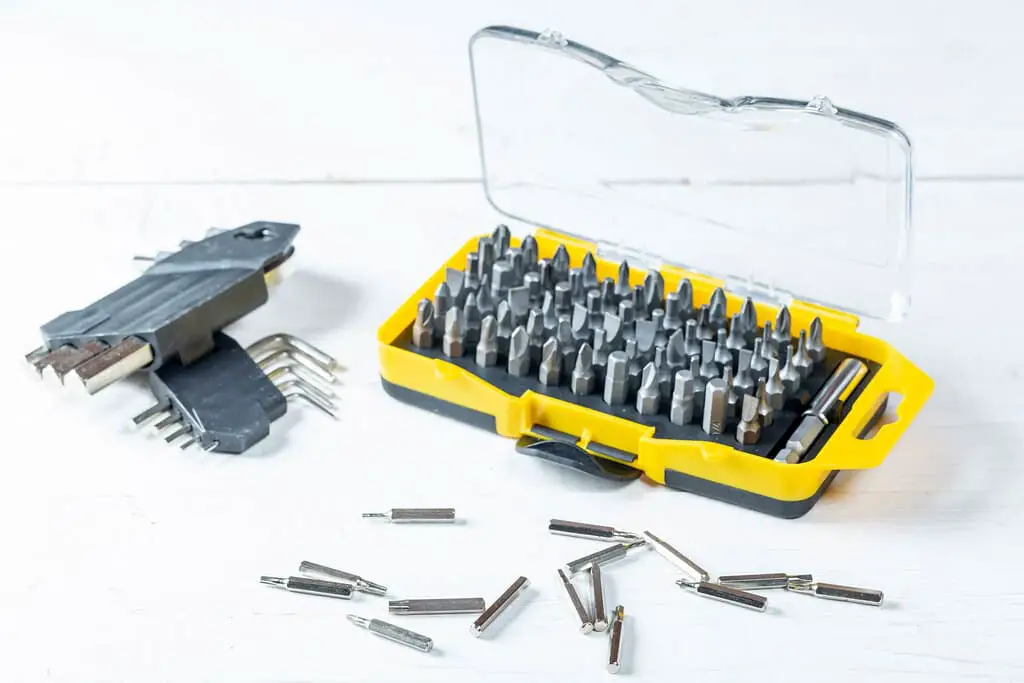
Anchor kits are accessories that secure the trampoline to the ground. They are important for safety and can prevent the trampoline from tipping over in high winds or during intense use.
Advantages of having an anchor kit include:
Safety: An anchor kit can prevent the trampoline from tipping over and causing injury.
Durability: By securing the trampoline to the ground, an anchor kit can prevent wear and tear on the frame and springs.
When choosing an anchor kit, ensure that it is appropriate for the size of your trampoline and the type of ground it will be anchored to. Follow the manufacturer’s instructions carefully for proper installation.
Basketball Hoops
Basketball hoops are an accessory that can be attached to the frame of the trampoline, allowing users to play basketball while jumping on the trampoline.
Advantages of having a basketball hoop include:
Fun: A basketball hoop can add a new level of excitement and challenge to trampoline use.
Exercise: Playing basketball on a trampoline can be a fun way to exercise and improve coordination.
When choosing a basketball hoop, consider the size of your trampoline and the height of the frame. Ensure that the hoop is securely attached and can withstand use.
Weather Covers
Weather covers are accessories that protect the trampoline from the elements, including rain, snow, and sun. They are typically made from durable, waterproof materials.
Advantages of having a weather cover include:
Protection: A weather cover can extend the life of the trampoline by protecting it from the elements.
Convenience: A weather cover can save time and effort by preventing the need for frequent cleaning and maintenance.
When choosing a weather cover, ensure that it is appropriate for the size of your trampoline and the climate in your area. Follow the manufacturer’s instructions for proper installation and care.
Maintenance and Care
Trampolines can be a fun way to get exercise, but they require proper maintenance and care to ensure their longevity and safety. In this section, we’ll discuss how to maintain and care for a trampoline, including cleaning and storage, and potential repairs that may be needed over time.
Maintenance and Care:
The following tips can help you keep your trampoline in good condition and ensure its longevity and safety:
- Regularly inspect your trampoline for any signs of wear or damage. Check the frame, springs, mat, and padding for tears, rust, or other damage. If you notice any damage, do not use the trampoline until it has been repaired.
- Clean your trampoline regularly. Use a mild soap and water to remove any dirt or debris. Avoid using harsh chemicals, as they can damage the trampoline’s materials. Rinse the trampoline thoroughly with a hose and allow it to air dry.
- Store your trampoline properly when not in use. Keep it in a dry, cool place, away from direct sunlight. If you’re storing it outside, use a weather cover to protect it from the elements.
Potential Repairs:
Over time, your trampoline may need some repairs to keep it safe and functional. Some common repairs include:
Replacing Springs: If a spring becomes stretched or broken, it should be replaced immediately. You can purchase springs individually or in sets, and installation is usually straightforward.
Replacing the Mat: If the mat becomes torn or worn, it should be replaced immediately. You can purchase replacement mats in specific sizes and for different trampoline brands. Installation may require some assistance.
Repairing the Frame: If the frame becomes damaged or rusted, it should be repaired or replaced. This may require the assistance of a professional.
Cleaning and Storage
Cleaning and storing your trampoline properly can help extend its lifespan and ensure it remains safe for use.
- Clean your trampoline regularly to remove dirt and debris. Use mild soap and water, and avoid using harsh chemicals that can damage the materials.
- Store your trampoline in a dry, cool place when not in use. If storing it outside, use a weather cover to protect it from the elements.
- Regularly inspect your trampoline for signs of wear or damage, and make any necessary repairs promptly to ensure its longevity and safety.
Budget Considerations When Purchasing a Trampoline
Trampolines can be a fun and healthy addition to any home, but they can also come with a significant cost. Therefore, it is important to establish a budget before deciding which trampoline to purchase.
Here are some considerations to help you determine a reasonable budget and balance quality with cost.
Determine Your Needs
Before setting a budget, consider your needs and intended use of the trampoline. If you are buying a trampoline for your children to play on occasion, a smaller and more affordable option may be suitable.
However, if you plan to use the trampoline for exercise or training purposes, it may be worth investing in a higher quality and more expensive model.
Research Prices
Do some research on the prices of trampolines to get an idea of what you can expect to pay for different models and sizes. Online marketplaces and sporting goods stores are good places to start.
Remember that larger trampolines and those with additional features will typically be more expensive than smaller, basic models.
Set a Budget
Once you have determined your needs and researched prices, set a budget that is reasonable for your financial situation. Consider your priorities and what features you are willing to pay extra for.
It may be helpful to have a price range in mind, rather than a specific dollar amount, to allow for some flexibility in your search.
Balance Quality with Cost
While it can be tempting to opt for the cheapest trampoline available, it is important to balance cost with quality. A poorly made trampoline can be dangerous and may require more repairs and maintenance in the long run, which can add up in costs.
Look for a sturdy trampoline, has quality materials and construction, and meets safety standards.
Consider Additional Costs
Remember that the cost of a trampoline is not the only expense to consider. Additional accessories, such as a ladder, anchor kit, or cover, may be necessary and will add to the overall cost.
It is also important to factor in maintenance and repair costs, such as replacing worn-out parts or hiring a professional to fix any damage.
FAQs
Q.1 What size trampoline should I get?
The size of the trampoline you should get will depend on the amount of space you have available in your backyard. Measure the area where you plan to place the trampoline and make sure to leave enough space around it for safety.
Trampolines come in a range of sizes, from small ones that are 8 feet in diameter to large ones that are 15 feet in diameter or more.
Q.2 What weight limit should I look for in a trampoline?
The weight limit you should look for will depend on who will be using the trampoline. If it will mainly be used by children, a weight limit of 150-200 pounds should be sufficient. However, if adults will also be using the trampoline, look for a weight limit of at least 250-300 pounds.
Q.3 What safety features should I look for in a trampoline?
Safety features to look for include enclosure nets, padding, and sturdy frames. The enclosure net will prevent users from falling off the trampoline, while padding will help prevent injuries if someone does fall. A sturdy frame will ensure that the trampoline is stable and won’t tip over.
Q.4 What are the different types of trampolines?
There are several different types of trampolines available, including round, rectangular, and oval-shaped trampolines. Round trampolines are typically the most popular and are best for recreational use.
Rectangular trampolines are ideal for gymnastics or other athletic activities, while oval-shaped trampolines offer a larger jumping surface and can accommodate more users at once.
Q.5 How much should I expect to spend on a trampoline?
The cost of a trampoline will depend on its size, features, and brand. Smaller trampolines can cost as little as $100, while larger, more advanced trampolines can cost several thousand dollars. Expect to spend at least a few hundred dollars on a good-quality trampoline with safety features.
Conclusion
In conclusion, choosing a trampoline involves careful consideration of several factors. It is important to determine the size and weight limit that will best suit your needs and the available space in your backyard.
Safety features such as enclosure nets, padding, and sturdy frames should also be taken into account.
Different types of trampolines are available, such as round, rectangular, and oval-shaped trampolines, each with its unique advantages. Additionally, materials and construction quality should be assessed, and budget considerations should be kept in mind.
Once you have chosen the right trampoline for your needs, it is important to maintain it properly to ensure its longevity and safety. With the help of this step-by-step guide, you can choose the perfect trampoline for your family and create years of fun memories in your backyard.
We hope this guide has helped you learn how to choose a trampoline. If you have any questions, please feel free to ask in the comments section below!

